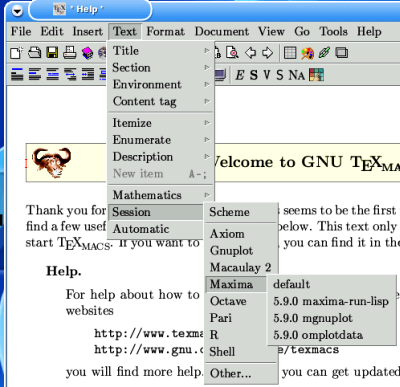

- Texmacs windows ramdisc driver#
- Texmacs windows ramdisc manual#
- Texmacs windows ramdisc software#
- Texmacs windows ramdisc code#
Texmacs windows ramdisc driver#
That requires a boot loader to contain a driver for each of the supported file systems, so they can be understood and accessed by the boot loader itself. Īnother approach is to make a boot loader aware of the underlying file systems, so kernel images are configured and accessed using their actual file paths.
Texmacs windows ramdisc manual#
This is not only cumbersome, but it also leaves the system in need of manual repairs in case something goes wrong during system updates. Also, in case of the maps changing their physical location, their locations need to be updated within the boot loader's MBR code, so the sectors indirection mechanism continues to work. Such maps need to be updated each time a kernel image changes its physical location on disk, due to installing new kernel images, file system defragmentation, etc. Usually, an additional level of indirection is required, in form of maps or map files – auxiliary files that contain a list of physical sectors occupied by kernel images. One possible approach for boot loaders is to load kernel images by directly accessing hard disk sectors without understanding the underlying file system. Thus, in BIOS-based systems, the duty of a boot loader is to access the content of those files, so it can be loaded into the RAM and executed. Kernels are in most cases stored as files residing on appropriate file systems, but the concept of a file system is unknown to the BIOS. The purpose of the remaining part(s) of the boot loader is to actually boot an operating system by configuring it and starting the kernel.
Texmacs windows ramdisc code#
The code in the MBR then does little more than starting the second part. Boot loaders with bigger footprints are therefore split into pieces, where the smallest piece fits in the MBR, while one or more larger pieces are stored in other locations such as empty sectors between the MBR and the first partition. Although such a small space can be sufficient for very simple boot loaders, it is not big enough to contain a boot loader supporting complex and multiple file systems, menu-driven selection of boot choices, etc. Together with the optional disk signature (four bytes) and disk timestamp (six bytes), this leaves between 434 and 446 bytes available for the machine code of a boot loader.

The legacy MBR partition table supports a maximum of four partitions and occupies 64 bytes, combined. Since 2009 there are hard disks available with a sector size of 4096 bytes, called Advanced Format disks, but as of October 2013, such hard disks are still accessed in 512-byte sectors, using the 512e emulation. For a long time, the size of a sector has been 512 bytes. This bootstrap program must be small because it has to fit in a single sector. The MBR is the first sector of the hard disk. When a computer is turned on, its BIOS finds the primary bootable device (usually the computer's hard disk) and runs the initial bootstrap program from the master boot record (MBR). The GNU operating system uses GNU GRUB as its boot loader, as do most Linux distributions and the Solaris operating system on x86 systems, starting with the Solaris 10 1/06 release.

It is predominantly used for Unix-like systems.

GNU GRUB was developed from a package called the Grand Unified Bootloader (a play on Grand Unified Theory ).
Texmacs windows ramdisc software#
GRUB is the reference implementation of the Free Software Foundation's Multiboot Specification, which provides a user the choice to boot one of multiple operating systems installed on a computer or select a specific kernel configuration available on a particular operating system's partitions. GNU GRUB (short for GNU GRand Unified Bootloader, commonly referred to as GRUB) is a boot loader package from the GNU Project. Linux, macOS, BSD, ( Solaris/ illumos (x86 port)), and Windows (through chainloading)


 0 kommentar(er)
0 kommentar(er)
